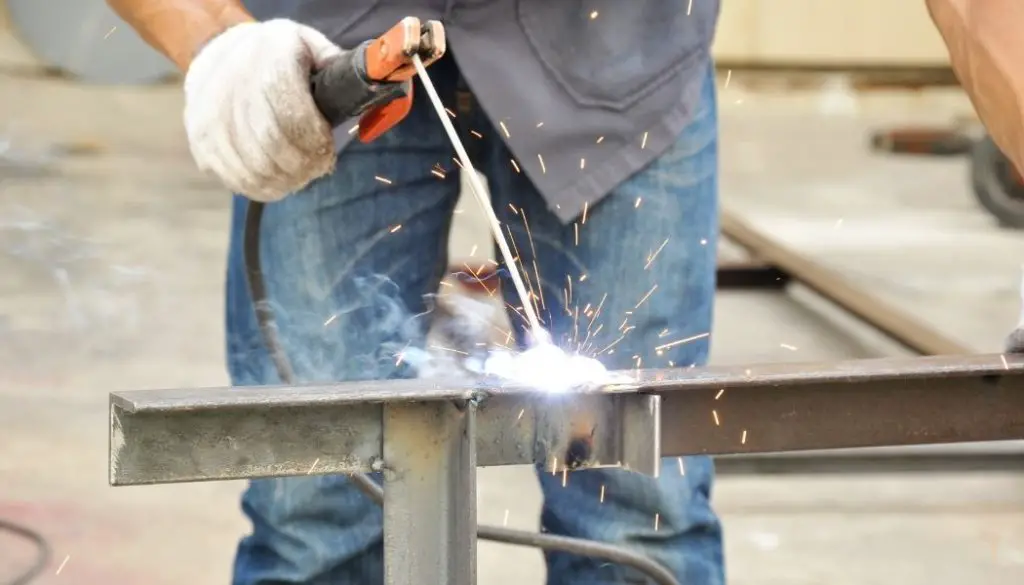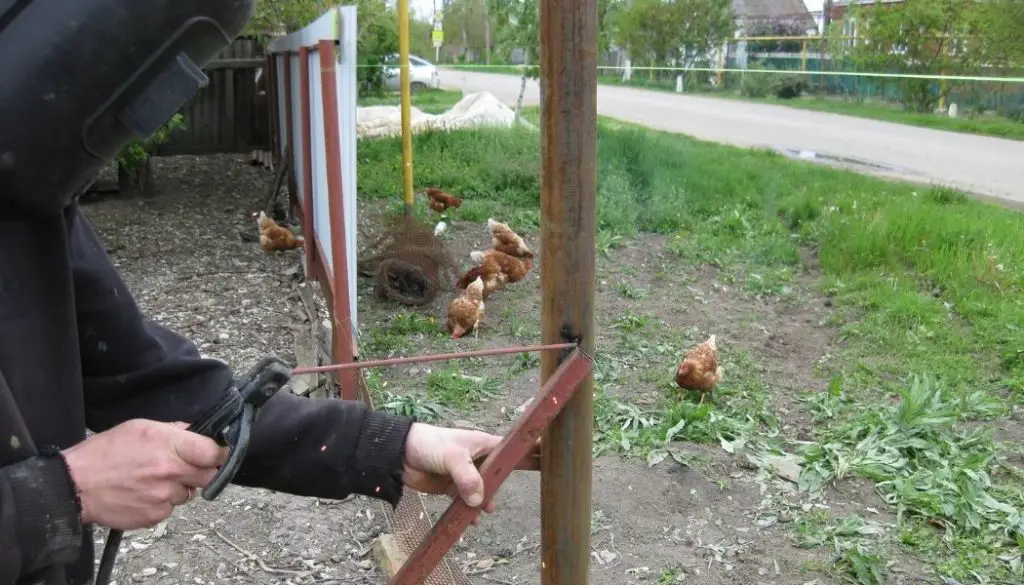Rod sticking during stick welding can be due to low amperage, improper arc length, excessive rod angle, or a dirty work surface. Adjust the amperage, maintain a short arc, use the correct rod angle, and clean the workpiece to prevent the electrode from sticking and ensure a smooth weld.
Everyone that starts welding, sooner or later asks themselves why the rod sticks to the workpiece when stick welding. This is indeed very annoying and can lead to poor-looking welds.
Common causes for a welding rod to stick are:
- Surface conditions
- Arc Lengths
- Amperage settings
- Material Thickness and Surface Heat
- Poor Welding Techniques
- Electrode Selection
- Electrode Angle
- Lack of Pre-Flow
- Preheating
- Contact Tip Size
Let’s examine each of these in detail.

Table of Contents
Why do welding rods stick to the base metal?
There are several reasons why the welding rod sticks to the base metal.
1. Surface Conditions
The surface conditions of the base metal can cause welding rods to stick. Rusty surfaces provide enough electrical contact points, which will result in sticking.
Rods can also stick if the surface is not properly prepared. Painted surfaces hinder adequate contact between electrical energy and the base metal, resulting in a “capacitor effect” that disrupts the electric flow.
2. Arc Lengths
If the electrode is incorrectly positioned, the arc length will vary greatly. This will cause electrical resistance and result in sticking to the workpiece.
Maintaining a consistent arc length throughout the welding process is crucial in preventing sticking.
In order to do this, you need to adjust the current setting to the material’s thickness and the speed at which you are welding. When welding thinner materials, it is normal for the arc length to increase since there is less metal.
3. Amperage settings
It could also be that the amperage settings are too low for the material thickness.
In many cases, a simple adjustment of the welding parameters will do. In other cases, however, sticking may indicate a more serious problem with your equipment or setup.
Follow these easy tips to adjust amperage settings correctly:
- Increase the amperage setting by 5%
- Strike an arc and check if the weld puddle is frozen or sluggish; then decrease amperage setting by 5%
- If you have trouble striking an arc, decrease amperage settings by 10%.
- It is also important to consider the type of metal you are welding. For example, if you increase amperage settings too much on stainless steel, oxidation will rapidly form and cause sticking problems.
4. Material Thickness and Surface Heat
Sticking problems may also arise when welding on a thick piece of metal if you do not have enough power supply or adequate torch cable length.
This problem arises because as the weld pool becomes deeper, it becomes harder for its heat to dissipate throughout the surrounding base metal. The result is localized melting along with excess electrical resistance/heating (voltage drop).
NOTE: High amperage settings only compound this effect further. As such, ensure that you increase amperage settings sufficiently as the material becomes thicker.
5. Poor Welding Techniques
Improper welding techniques can also result in sticking problems. For example, poor arc stability may cause you to lose control over the electrode. This is particularly problematic on certain materials such as stainless steel for which high heat input is essential.
If you cannot stabilize the arc, the welding current will take the path of least resistance and stick to the electrode rather than going into the workpiece.
In addition, high travel speeds on thin materials may also cause sticking. This is why it is important to maintain a low travel speed if you are using a 1/16-in stick electrode for example.
6. Electrode Selection
Another cause of sticking while stick welding is caused by using the wrong electrode for your application.
Here are a few tips on choosing Right Electrode for your metal:
- Pick electrode size according to your work piece thickness – When you choose a too small electrode, it will be difficult to maintain a consistent current and the arc length will vary greatly. If your electrode is too big for the thickness of your work piece, it will create high heat and cause sticking.
- Pick electrodes by material type – If you are welding on unknown metals or difficult to weld materials, use electrodes made for the same metal. For example, do not use mild steel electrode on stainless steel.
- Avoid welding dissimilar metals – When welding dissimilar metals, it is common for one of the two metal to be sucked into the gun and melted. This process is called “arcing-in” and it can be prevented by maintaining a small arc length.
- Pick electrodes based on the welding application, such as AC or DC.

7. Electrode Angle
One way to avoid rod sticking when stick welding is by maintaining correct electrode angles (polarity).
You should generally maintain a 20 to 30 degrees angle when stick welding. Holding the electrode at too steep or at too shallow angles will cause sticking and poor-looking welds. The trick is to find the right balance between low and high angles.
Welding angle for AC and DC can vary
When AC is used, AC welders will typically maintain an electrode angle of about 20 – 30 degrees as mentioned above. Most manufacturers recommend maintaining the electrode angle at around 45 degrees on DC welders.
This difference in weld angles is due to the difference in polarity as explained below:
AC – AC is a direct current that provides a positive electrode and negative ground. For this reason, you must maintain an angle of 20-30 degrees on the electrode to keep polarity consistent.
DC – As mentioned before, DC is a constant polarity with the positive electrode and negative ground. Maintaining an angle of 45 degrees will prevent the rod from sticking to the base metal.
8. Lack of Pre-Flow
Pre-flow is done before the electrode reaches the workpiece, which helps stabilize the arc, reduce spatter, and prevent sticking.
TIP: You need to pre-flow for about 2 seconds at 20 amps, or 15 seconds at 40 amps. You can use much higher currents to pre-flow, but it is not recommended.
9. Preheating
Preheating can be used for difficult metals, either if your metal is difficult to weld or old and brittle. When you preheat, you generate heat using an open flame before welding.
Preheating can be done with torches (acetylene, propane) or electricity (induction heating). It is usually done for short periods since it can cause excess heat damage to the metal.
NOTE: Make sure that you do not preheat excessively long periods of time because this can cause warping and cracking.
10. Contact Tip Size
When welding, you should maintain a gap around 0.3 to 0.5 inches between the electrode and the contact tip. If this gap is too big or too small, it will cause sticking to occur on your metal. Make sure that your gap is set correctly for best results.
What To Do When the Welding Rod Sticks?
When welding, there is always a possibility that the electrodes will stick. When this happens, you should stop immediately and
- Let the electrodes cool down – When your electrode stick to the work piece, you should wait until the electrodes stop emitting sparks and turn black: this usually takes about 10 seconds.
- Knock them out – Once they are cooled down, it is possible to knock them out using chipping hammer or special pliers (similar to what you use for removing nails).
- Clean them off – To clean out the electrodes, use either wire brush or sand paper.
- Replace tips – When electrodes are stuck it can cause damage to the contact tip (and increase wear and tear). Make sure that you replace the tips if needed.
NOTE: Remember to wear gloves! Cleaning helps maintain electrical continuity between tip of rod and work piece which keeps weld quality high…
What is the name of the rod used in stick welding?
The most common electrodes used in stick welding are called E6010 and E6011 electrodes. These can handle AC and DC, making them one of the most widely used electrodes on the market today.
Another type of electrode is E7018. It also works in both AC and DC modes, but it’s more suitable for heavy current applications than E6010 and E6011 electrodes.
TIP: Read my post about Difference between 7018 and 6010 welding rods
When should I use each electrode?
E6010: welding thin or thick metals (it can go from 5/64 inches up to 1/8 inches).
E6011: welding metal pieces between 3/16 inches to 1/2 inch thick.
E7018: when you need to weld thicker metals (between 3/16 inches to 1/2 inch thick).
What is the easiest welding rod to stick weld with?
The best and easiest welding rod for general purpose (and beginners) is the E7018 electrode. It works in both AC and DC mode and it’s easy enough to use. Made from best quality material, this electrode has top notch performance.
How to tell if my rod is sticking?
Sometimes there are signs that your electrode will stick to the metal before it actually happens. These include:
Lower quality welds – electrodes tend to get stuck when the arc length is too long; this causes the electrode to lose heat and result in lower quality welds.
Spitting and sputtering – electrodes tend to get stuck when the welding speed is too low or when there’s a high amount of moisture in welding area. Lack of fluidity (or sticking) is usually caused by using too much SSP (slag protecting gas).
Premature ignition – Usually caused by spattering. This happens when metal particles fly out of the tip, which can cause premature ignition of small pieces of base metal that are not yet molten.
Lack of penetration – Sometimes sticking occurs due to lack of fluidity; it can also be caused by excessive amperage for given thicknesses. If you are using too high amperage, your electrode will start sticking.
Electrode getting stuck to workpiece – This usually happens if the welder is not wearing gloves; it’s also caused by moisture accumulating on the electrode and then transferring to metal while welding.
Related Questions
What are some issues when stick welding?
The three main issues in stick welding techniques:
1) Stick electrodes do not eject.
2) Stick electrodes do not extend properly.
3) Excessive spatter.
What are some precautions when working around an arc welder?
There are a few precautions that you have to take when working around an arc welder:
1) Fire hazards.
2) Eye damage.
3) Explosions.
4) Injuries from spatter or sparks caused by electric arcs between electrode and workpiece.
5) Third-degree burns.
Can a stick electrode work with AC current only?
Yes, most common stick electrodes (E6010 and E7018) can work on AC and DC current.
Read More
- 7 Vertical Stick Welding Tips to Increase Weld Quality
- 13 Surefire Ways to Improve Your Stick Welding Skills
- Welding Cast Steel
- What are the causes of welding spatter?
- 5 Beginner Welding Mistakes
- Differences Between Welding, Brazing and Soldering
- Beginner welding Projects
- Protective equipment needed
- Types of Welding
- 101 Welding Tips
